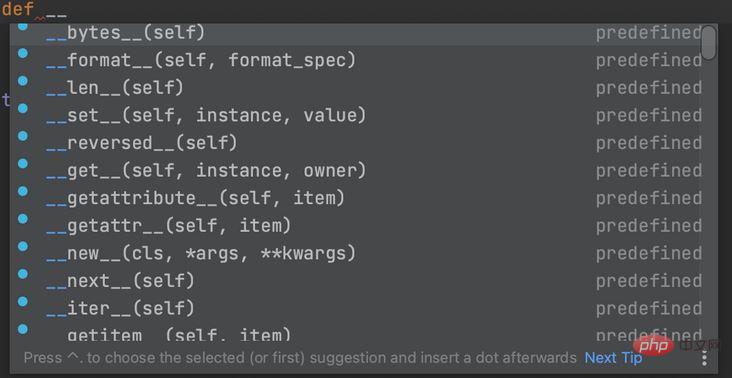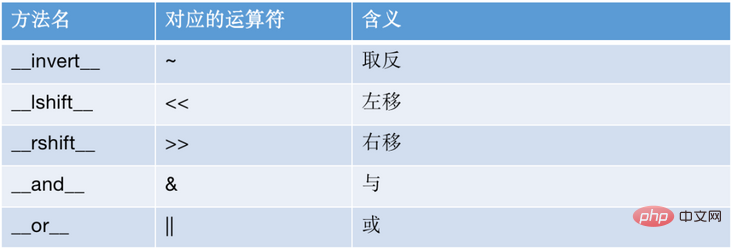完全掌握Python中的雙下法
Jul 21, 2022 pm 05:50 PM本篇文章為大家帶來了關於Python的相關知識,Python中有一些特殊方法的方法名稱都是以雙下劃線開始和結束,所以又被稱為雙下方法,下面一起來看一下,希望對大家有幫助。

【相關推薦:Python3影片教學 】
前言
大家在寫Python 程式碼的時候有沒有這樣的疑問。
為什麼數學中的 號,在字串運算中卻變成拼接功能,如'ab' 'cd'結果為abcd;而*號變成了重複功能,如'ab' * 2結果為abab。
為什麼某些物件print能輸出數據,而print自訂的類別物件卻輸出一堆看不懂的程式碼<__main__. MyCls object at 0x105732250>。
不是因為系統做了特殊定制,而是 Python 中有一類特殊的方法,在某些特定的場合會自動呼叫。如,在字串類別str中定義了__add__方法後,當程式碼遇到字串相加'ab' 'cd'時,就會自動呼叫__add__方法完成字串拼接。
因為這類特殊方法的方法名稱都是以雙底線開始和結束,所以又被稱為雙下方法。
Python 中的雙下方法很多,今天我們對它做個詳解。

Python中的雙下方法
1. init方法
__init__的方法是很多人接觸的第一個雙下方法。
class A:
def __init__(self, a):
self.a = a當呼叫A()實例化物件的時候,__init__方法會被自動調用,完成物件的初始化。
2. 運算子的雙下方法
在類別中定義運算子相關的雙下方法,可以直接在類別物件上做加減乘除、比較等操作。
這裡,定義一個尺子類別Rule,它包含一個屬性r_len代表尺的長度。
class Rule:
def __init__(self, r_len):
self.r_len = r_len2.1 比較運算子
如果想依照尺的長度對不同的尺子做比較,需要在Rule類別中定義比較運算子。
class Rule:
def __init__(self, r_len):
self.r_len = r_len
# < 运算符
def __lt__(self, other):
return self.r_len < other.r_len
# <= 运算符
def __le__(self, other):
return self.r_len <= other.r_len
# > 运算符
def __gt__(self, other):
return self.r_len > other.r_len
# >= 运算符
def __ge__(self, other):
return self.r_len >= other.r_len這裡定義了<、<=、>、>=四個比較運算符,這樣就可以用下面的程式碼比較Rule物件了。
rule1 = Rule(10) rule2 = Rule(5) print(rule1 > rule2) # True print(rule1 >= rule2) # True print(rule1 < rule2) # False print(rule1 <= rule2) # False
當用>比較rule1和rule2的時候,rule1物件會自動呼叫 __gt__方法,並將rule2物件傳給other參數,完成比較。
下面是比較運算子的雙下方法

比較運算子雙下方法
2.2 算術運算子
#可以支援類別物件加減乘除。
def __add__(self, other):
return Rule(self.r_len + other.r_len)這裡定義了__add__方法,對應的是 運算符,他會把兩個尺子的長度相加,並產生新的尺。
rule1 = Rule(10) rule2 = Rule(5) rule3 = rule1 + rule2
下面是算術運算子的雙下方法

#2.3 反向算術運算子
它支援其他類型的變數與Rule類別相加。以__radd__方法為例
def __radd__(self, other):
return self.r_len + otherrule1 = Rule(10) rule2 = 10 + rule1
程式執行10 rule1時,會嘗試呼叫int類別的__add__但int類別類別沒有定義與Rule類別物件相加的方法,所以程式會呼叫 號碼右邊物件rule1的 __radd__方法,並把10傳給other參數。
所以這種運算子又叫右加運算子。它所支援的運算子與上面的算術運算子一樣,方法名前加上r即可。
2.4 增量賦值運算子
增量賦值運算子是 =、-=、*=、 /=等。
def __iadd__(self, other):
self.r_len += other
return selfrule1 = Rule(10) rule1 += 5
除了__pmod__方法,其他的跟算數運算子一樣,方面名前都加i。
2.4 位元運算子
這部分支援以二進位進行取反、移位和與或非等運算。由於Rule類別不涉及位元運算,所以我們換一個例子。
定義二進位字串的類別BinStr,包含bin_str屬性,表示二進位字串。
class BinStr:
def __init__(self, bin_str):
self.bin_str = bin_strx = BinStr('1010') #创建二进制字符串对象 print(x.bin_str) # 1010
為BinStr定義一個取反運算子~
# ~ 运算符
def __invert__(self):
inverted_bin_str = ''.join(['1' if i == '0' else '0' for i in self.bin_str])
return BinStr(inverted_bin_str)__invert__方法中,遍历bin_str字符串,将每位取反,并返回一个新的BinStr类对象。
x = BinStr('1011') invert_x = ~x print(invert_x.bin_str) # 0100
下面是位运算符的双下方法

这部分也支持反向位运算符和增量赋值位运算符,规则跟算数运算符一样,这里就不再赘述。
3.字符串表示
这部分涉及两个双下方法__repr__和__format__,在某些特殊场景,如print,会自动调用,将对象转成字符串。
还是以BinStr为例,先写__repr__方法。
def __repr__(self):
decimal = int('0b'+self.bin_str, 2)
return f'二进制字符串:{self.bin_str},对应的十进制数字:{decimal}'x = BinStr('1011') print(x) # 输出:二进制字符串:1011,对应的十进制数字:11
当程序执行print(x)时,会自动调用__repr__方法,获取对象x对应的字符串。
再写__format__方法,它也是将对象格式化为字符串。
def __format__(self, format_spec):
return format_spec % self.bin_strprint('{0:二进制字符串:%s}'.format(x))
# 输出:二进制字符串:1011当.format方法的前面字符串里包含0:时,就会自动调用__format__方法,并将字符串传给format_spec参数。
4.数值转换
调用int(obj)、float(obj)等方法,可以将对象转成相对应数据类型的数据。
def __int__(self):
return int('0b'+self.bin_str, 2)x = BinStr('1011') print(int(x))
当调用int(x)时,会自动调用__int__方法,将二进制字符串转成十进制数字。
数值转换除了上面的两个外,还有__abs__、__bool__、__complex__、__hash__、__index__和__str__。
__str__和__repr__一样,在print时都会被自动调用,但__str__优先级更高。
5.集合相关的双下方法
这部分可以像集合那样,定义对象长度、获取某个位置元素、切片等方法。
以__len__和__getitem__为例
def __len__(self):
return len(self.bin_str)
def __getitem__(self, item):
return self.bin_str[item]x = BinStr('1011') print(len(x)) # 4 print(x[0]) # 1 print(x[0:3]) # 101
len(x)会自动调用__len__返回对象的长度。
通过[]方式获取对象的元素时,会自动调用__getitem__方法,并将切片对象传给item参数,即可以获取单个元素,还可以获取切片。
集合相关的双下方法还包括__setitem__、__delitem__和__contains__。
6.迭代相关的双下方法
可以在对象上使用for-in遍历。
def __iter__(self):
self.cur_i = -1
return self
def __next__(self):
self.cur_i += 1
if self.cur_i >= len(self.bin_str):
raise StopIteration() # 退出迭代
return self.bin_str[self.cur_i]x = BinStr('1011')
for i in x:
print(i)当在x上使用for-in循环时,会先调用__iter__方法将游标cur_i置为初始值-1,然后不断调用__next__方法遍历self.bin_str中的每一位。
这部分还有一个__reversed__方法用来反转对象。
def __reversed__(self):
return BinStr(''.join(list(reversed(self.bin_str))))x = BinStr('1011') reversed_x = reversed(x) print(reversed_x) # 输出:二进制字符串:1101,对应的十进制数字:13
7.类相关的双下方法
做 web 开发的朋友,用类相关的双下方法会更多一些。
7.1 实例的创建和销毁
实例的创建是__new__和__init__方法,实例的销毁是__del__方法。
__new__的调用早于__init__,它的作用是创建对象的实例(内存开辟一段空间),而后才将该实例传给__init__方法,完成实例的初始化。
由于__new__是类静态方法,因此它可以控制对象的创建,从而实现单例模式。
__del__方法在实例销毁时,被自动调用,可以用来做一些清理工作和资源释放的工作。
7.2 属性管理
类属性的访问和设置。包括__getattr__、__getattribute__、__setattr__和__delattr__方法。
__getattr__和__getattribute__的区别是,当访问类属性时,无论属性存不存在都会调用__getattribute__方法,只有当属性不存在时才会调用__getattr__方法。
7.3 属性描述符
控制属性的访问,一般用于把属性的取值控制在合理范围内。包括__get__、__set__和__delete__方法。
class XValidation:
def __get__(self, instance, owner):
return self.x
def __set__(self, instance, value):
if 0 <= value <= 100:
self.x = value
else:
raise Exception('x不能小于0,不能大于100')
def __delete__(self, instance):
print('删除属性')
class MyCls:
x = XValidation()
def __init__(self, n):
self.x = n
obj = MyCls(10)
obj.x = 101
print(obj.x) # 抛异常:Exception: x不能小于0,不能大于100上述例子,通过类属性描述符,可以将属性x的取值控制在[0, 100]之前,防止不合法的取值。
8.总结
虽然上面介绍的不是所有的双下方法,但也算是绝大多数了。
虽然双下方法里可以编写任意代码,但大家尽量编写与方法要求一样的代码。如,在__add__方法实现的不是对象相加而是相减,虽然也能运行,但这样会造成很大困惑,不利于代码维护。
【相关推荐:Python3视频教程 】
以上是完全掌握Python中的雙下法的詳細內容。更多資訊請關注PHP中文網其他相關文章!

熱門文章

熱門文章

熱門文章標籤

記事本++7.3.1
好用且免費的程式碼編輯器

SublimeText3漢化版
中文版,非常好用

禪工作室 13.0.1
強大的PHP整合開發環境

Dreamweaver CS6
視覺化網頁開發工具

SublimeText3 Mac版
神級程式碼編輯軟體(SublimeText3)
 Google AI 為開發者發佈 Gemini 1.5 Pro 和 Gemma 2
Jul 01, 2024 am 07:22 AM
Google AI 為開發者發佈 Gemini 1.5 Pro 和 Gemma 2
Jul 01, 2024 am 07:22 AM
Google AI 為開發者發佈 Gemini 1.5 Pro 和 Gemma 2
 只要250美元,Hugging Face技術主管手把手教你微調Llama 3
May 06, 2024 pm 03:52 PM
只要250美元,Hugging Face技術主管手把手教你微調Llama 3
May 06, 2024 pm 03:52 PM
只要250美元,Hugging Face技術主管手把手教你微調Llama 3














